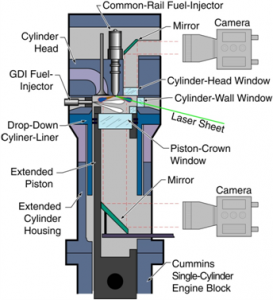The Heavy-Duty Diesel and Gaseous-Fueled Engine Laboratory uses laser-based and imaging diagnostics to develop the science base of in-cylinder processes needed by the heavy-duty engine industry. Our research provides engineers with the necessary understanding to design cleaner, more fuel-efficient engines. Fuel injection, combustion processes, and emissions formation are studied in a research engine that retains the basic geometry of a Cummins six-cylinder N-14 highway truck engine, but the single-cylinder version has been modified extensively for research. Added to a standard common-rail diesel fuel injector in the cylinder head is a gasoline direct-injection fuel injector mounted in the cylinder wall. This feature allows the formation of a well-mixed charge for combustion research and for certain optical diagnostics. Additionally, the engine is fitted with a gaseous fuel system that allows for both port fuel injection and direct-injection at pressures as high as 600 bar. With multiple injection systems, the facility allows engine operation with two different fuels (dual fuel), which can have emissions and efficiency advantages.

To facilitate optical diagnostics, the research engine has several windows. First, instead of the standard 150 mm (6 in.) tall all-metal piston, the research engine has a 650 mm (26 in.) tall extended piston with a 100 mm (4 in.) diameter crown window to allow imaging access to the piston bowl. An additional 50 mm (2 in.) diameter window mounted in the cylinder head provides imaging access to the squish region above the bowl. Smaller 30 mm by 50 mm (1.2 in. by 2 in.) rectangular windows in the cylinder walls provide access for laser illumination. The engine’s drop-down cylinder liner allows manual access to the combustion chamber, so the windows can be quickly cleaned between engine runs.
Pulsed light from a high-power Nd:YAG laser is used for various planar measurements, including
- in-cylinder liquid fuel penetration via Mie scattering
- vapor-phase fuel concentration via Rayleigh scattering or fuel-tracer fluorescence
- in-cylinder soot formation via laser-induced incandescence (LII) of soot
- laser-induced fluorescence (LIF) of combustion-generated formaldehyde and polycyclic aromatic hydrocarbons
A second Nd:YAG laser is coupled to an optical parametric oscillator to obtain color-tunable light emission for spectroscopic diagnostics, such as fluorescence of OH and NO molecules, that are used to measure flame structure and pollutant formation. The laboratory is also equipped with a flat-flame, gaseous-fuel burner for optical-diagnostic development and optimization of laser wavelength tuning on molecular absorption lines.